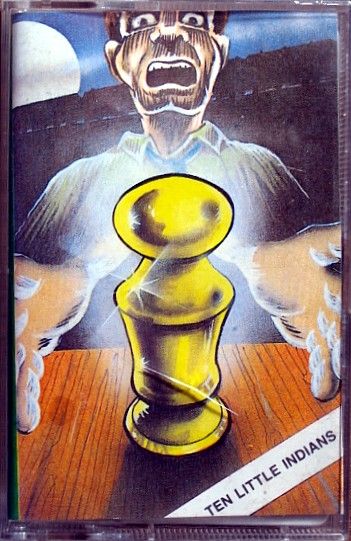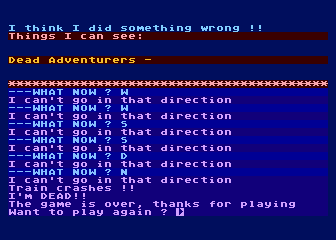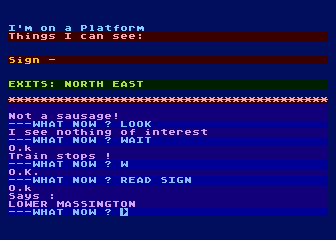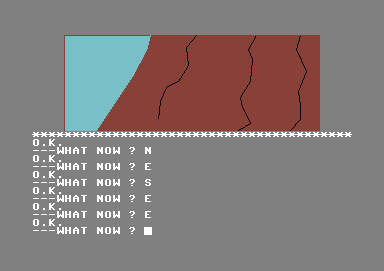Retro Replay Review
Gameplay
Ten Little Indians offers a classic interactive fiction experience where every command matters. From the moment you board the train, you must carefully choose your actions to prevent a deadly crash within a strict move limit. This opening sequence sets the tone for a game that rewards thoughtful exploration and precise planning.
Once you arrive at Lower Massington station, the shift from an urgent mini-mission to a sprawling puzzle hunt keeps you on your toes. Your main objective is to recover ten colored figurines scattered throughout Major Johnstone-Smythe’s estate. Each discovery requires examining objects from every conceivable angle—under tables, behind curtains, even inside seemingly mundane household items.
The upgrade to a full-sentence parser provides a richer command vocabulary than earlier two-word systems. Instead of “GET LAMP,” you can type “PICK UP SILVER LAMP AND EXAMINE BASE,” which opens up more nuanced interactions. While early releases may still feel a bit rigid, most versions let you experiment freely, rewarding creative thinking and thorough inventory management.
Graphics
As with many games in the Mysterious Adventures series, Ten Little Indians leans heavily on descriptive prose rather than visual flair. There are no animated sequences or elaborate hand-drawn screens; instead, evocative text passages paint vivid mental images of the mansion’s dusty corridors, ornate parlors, and secret nooks.
If you’re accustomed to modern graphics, the minimal visual presentation may feel sparse. However, this simplicity encourages your imagination to run wild, turning every paragraph into a personalized scene. Occasional static illustrations—often in monochrome—serve as atmospheric chapter headers but never overshadow the text-driven core.
The real artistry lies in pacing. Well-titled rooms and careful scene descriptions help you map out the mansion’s layout, and brief line art sketches hint at where hidden doors or stairwells might lie. Though primitive by today’s standards, these visual cues blend seamlessly with the prose, making you truly feel like a detective on the trail.
Story
Inspired by Agatha Christie’s And Then There Were None, Ten Little Indians weaves a murder-mystery atmosphere into a treasure hunt. Major Johnstone-Smythe left his fortune in the form of a golden statue, but to discover its location you must first gather ten worthless replicas. Each figurine holds a piece of the final puzzle.
The game’s narrative excels in building suspense. From cryptic journal entries to ominous creaks in the floorboards, the script keeps you guessing about the mansion’s secrets and the Major’s final intentions. The tension rises as you inch closer to completing your collection, with every figurine recovered unveiling another clue.
While there’s no cast of ghouls or spectral voices, the isolated mansion setting creates an eerie sense of solitude. You aren’t racing against other guests—your only competition is time and the puzzle itself. This focus on solitary deduction makes each deduction feel all the more rewarding when you finally piece together the statue’s hiding place.
Overall Experience
Ten Little Indians captures the essence of early 1980s interactive fiction: challenging puzzles, text-driven immersion, and a compelling whodunit twist. Modern players may need to adjust to the deliberate pacing and occasional parser frustrations, but fans of classic text adventures will find this gem both nostalgic and engaging.
The limited moves during the train sequence teach you the importance of planning, while the mansion’s sprawling layout demands attention to detail and meticulous note-taking. If you enjoy mapping rooms, cataloguing items, and feeling that genuine “aha” moment when a hidden figurine turns up, this title delivers in spades.
Overall, Ten Little Indians stands as a testament to the creativity possible in text-based games. Its thoughtful puzzles and suspenseful storytelling offer a unique challenge that modern point-and-click adventures rarely replicate. For collectors of interactive fiction or anyone seeking an intellectual treasure hunt, this is a must-explore classic.
 Retro Replay Retro Replay gaming reviews, news, emulation, geek stuff and more!
Retro Replay Retro Replay gaming reviews, news, emulation, geek stuff and more!









Reviews
There are no reviews yet.